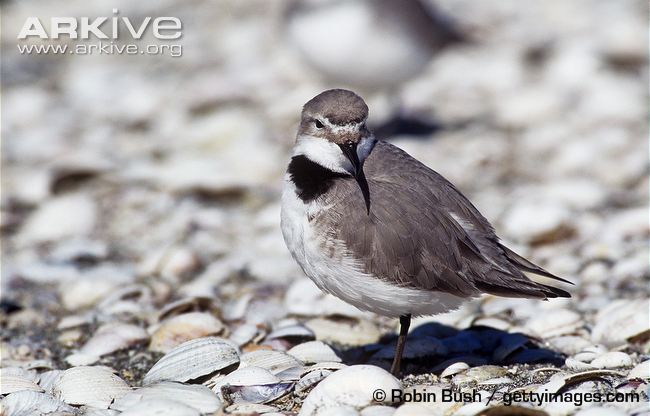
Anarhynchus frontalis
SUBFAMILY
Charadriinae
TAXONOMY
Anarhynchus frontalis Quoy and Gaimard, 1830, New Zealand.
Monotypic.
OTHER COMMON NAMES
English: Wry-billed plover, crook-bill plover; French: Pluvieranarhyngue;
German: Schiefschnabelregenpfeifer; Spanish:
Chorlitejo Piquituerto.
PHYSICAL CHARACTERISTICS
7.75–8 in (19.7–20 cm); weight: males 2.1 oz (59.5 g), females
2.0 oz (56.7 g). Unique in having a bill that bends to the
right at about a 12° angle. White forehead extends backwards.
Dark gray band extends from bill, continues under
eye, gradually lightening toward crown. Crown is nearly black
where it meets white forehead. Rest of upperparts are uniform
bluish gray, including wing coverts that are edged in
white. Flight feathers are brown with outermost flight feathers
gray with white edges. A broad, black band covers upper
breast. Bill is black and legs are dark gray. Female similar,
but breast band paler and narrower and crown is light where
it meets white forehead. Breast band absent in juveniles and
winter plumage.
DISTRIBUTION
Canterbury and Otago, South Island, New Zealand. Winters
mainly on the Firth of Thames at Manukau Harbor, and on
the Kaipara River, North Island, New Zealand.
HABITAT
Nest on large expanses of stones near rivers. During nonbreeding
season most often found on silty mudflats near high
tide mark on sheltered coasts and estuaries.
BEHAVIOR
Large pre-migratory flocks at the Firth of Thames perform
elaborate mass aerial displays.
FEEDING ECOLOGY AND DIET
Probes in mud, but also sweeps the bill sideways, capturing
tiny crustaceans from water surface. Also pecks and probes between
stones and sweeps tiny invertebrates from under stones
in riffle areas. Feeds on spiders, insects, crustaceans, small mollusks,
small fish, and eggs. Larval mayflies and caddisflies are
commonly eaten.
REPRODUCTIVE BIOLOGY
Have strong fidelity to breeding territories and even nest sites.
Birds often pair with same mate in consecutive years, perhaps
because of nest site tenacity. Breeding does not occur until second
or third year. Typically nest on higher banks and parts of
islands in wide areas of shingle with fairly large stones. Male
forms scrape, lined by pebbles flicked into the scrape or regurgitated
from the crop. Clutch size is two. Parental duties are
shared. One male shared incubation of a four-egg clutch with
two females. Incubation requires about 31 days, and young
fledge at about 29 days. Typically nest again after first clutch
fledges.
CONSERVATION STATUS
Classified as Vulnerable; population of 3,000–5,000 birds appears
to be declining. Breeding habitat is deteriorating due to
increasing recreational use of rivers and to invasion of weeds,
apparently as a result of hydroelectric plants upriver. Predation
by stoat (Mustela erminea), cats, and kelp gulls (Larus dominicanus)
is probably significant.
SIGNIFICANCE TO HUMANS
Shot for sport until protected in 1940.
Photo Gallery of - Wrybill




 Animalia Life
Animalia Life